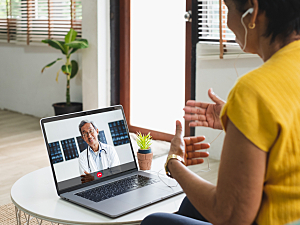Hospital-level care at home has been shown to have excellent outcomes for selected acutely ill adults. However, the time required for physicians to travel to patients’ homes can limit the geographic reach and scale-up of a home hospital program.
In a noninferiority, randomized controlled trial, David M. Levine, MD, MPH, MA, associate physician in the Division of General Internal Medicine & Primary Care at Brigham and Women’s Hospital, and Jeffrey L. Schnipper, MD, MPH, a physician in the division, and colleagues found patients who received predominantly remote physician care via videoconference had a non-inferior number of adverse events compared with those who had only in-home care.
However, as the team reports in JAMA Network Open, in-home physician care was necessary more often than planned for one-fifth of patients assigned to the remote group.
Methods
Between August 3, 2019, and March 26, 2020, study participants were recruited in the emergency department and medical ward at the Brigham or an affiliated community hospital. 172 patients who had an eligible illness and lived within a five-mile catchment area were randomized to the:
- Remote group—The attending physician performed an initial in-home visit on admission, followed by a daily video visit facilitated by a home hospital nurse or paramedic who performed examination maneuvers as needed, including the transmission of heart and lung sounds. The clinical team could choose to see the patient in person at any time if the physician considered it medically necessary. If a physician’s time on service (typically seven days) ended, but the patient remained on service, the incoming physician performed a single in-home visit, then continued with remote visits
- Control group—The attending physician performed rounds each day in the patient’s home, alongside a home hospital nurse or paramedic
Except for the physician interaction, patients received the same home hospital services, including in-home nurse visits twice daily. In both groups, patients had immediate after-hours access via video and telephone to their physician, who could dispatch a paramedic to the home and bring the physician in by video if needed.
Because of the COVID-19 pandemic, the trial was halted abruptly on April 26, 2020, and as much care as possible was shifted to the remote model.
Primary Outcome
The primary outcome was the number of adverse events during a patient’s admission.
The events eligible to be recorded were falls, delirium, potentially preventable venous thromboembolism, new pressure injury, thrombophlebitis at a peripheral intravenous site, catheter-associated urinary tract infection, new Clostridioides difficile infection, new methicillin-resistant Staphylococcus aureus infection, new arrhythmia, hypokalemia, acute kidney injury, transfer back to the hospital, unplanned mortality during admission, and unplanned mortality within 30 days after discharge.
Only a few adverse events were recorded:
- Transfer back to the hospital—3.6 per 100 patients for the remote group vs. 2.3 per 100 patients for the control group
- Delirium—4.8 vs. 1.1
- Falls—1.2 vs. 2.3
The mean adjusted adverse event count was 6.8 vs. 3.9 events per 100 patients (difference, 2.8; 95% CI, −3.3 to 8.9), supporting noninferiority.
Secondary Outcomes
Three secondary outcomes were analyzed:
- The Picker Patient Experience Questionnaire-15—The mean adjusted score was 13.46 for the remote group vs. 13.68 for the control group (difference, −0.22; 95% CI, −1.00 to 0.56), supporting noninferiority
- Global patient experience rating (scale of 0–10, with 10 indicating best experience)—The mean adjusted rating was 9.50 vs. 9.62 (difference, −0.12; 95% CI, −0.44 to 0.21), supporting noninferiority
- 30-day readmission rate—The mean adjusted rate was 5.70% vs. 3.43% (difference, 2.28; 95% CI, −3.23 to 7.79), which was inconclusive
Physician Visits
16 patients in the remote care group (19%) required in-home physician visits beyond the initial in-home admission visit. Physicians performed a median of 2.5 additional in-home visits per patient who required them.
Evaluating the Findings
An important conclusion from this trial is that home hospital programs should have the capacity to provide in-home physician visits. It’s likely the outcomes in the remote group would not have reached noninferiority if the additional in-home visits had not occurred.
Many patients in the remote group who needed additional in-home physician visits did not speak English well or had severe visual or auditory impairments, cognitive deficits, or complicated presentations. They may not have been assigned to remote care outside of a trial setting.
Still, high-quality interpretation services should be integrated into the video telehealth platform to ensure equity for patients who don’t speak English as their primary language.
